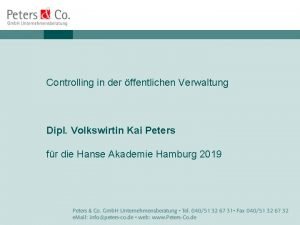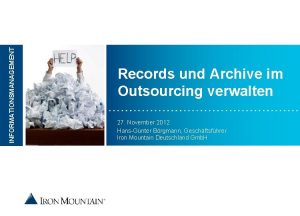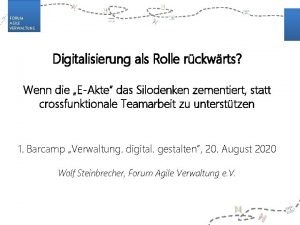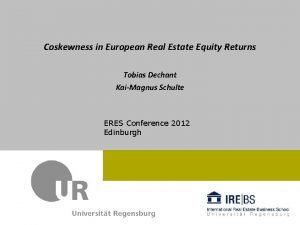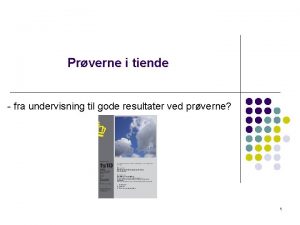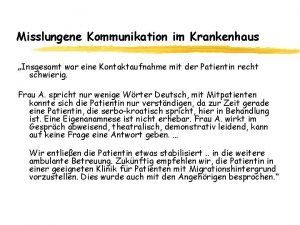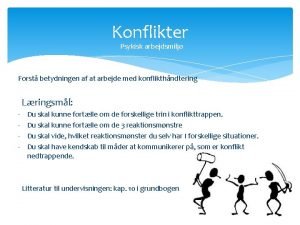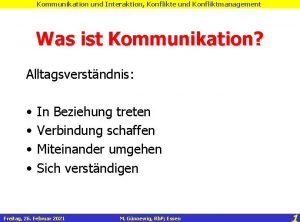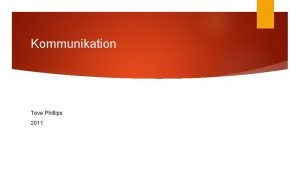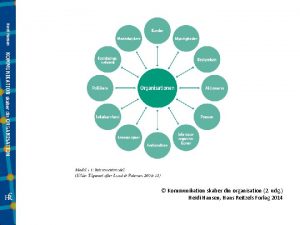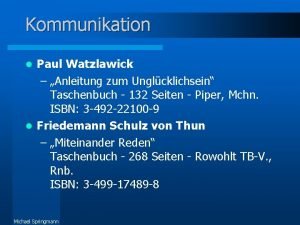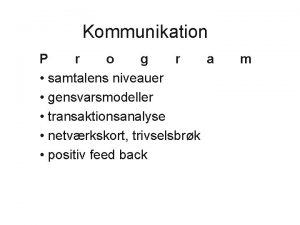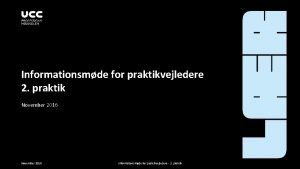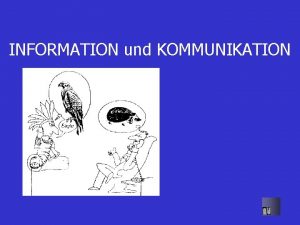Dr Max Mustermann Referat Kommunikation Marketing Verwaltung Coskewness





























- Slides: 29

Dr. Max Mustermann Referat Kommunikation & Marketing Verwaltung Coskewness in European Real Estate Equity Returns Tobias Dechant Kai-Magnus Schulte ERES Conference 2012 Edinburgh

Coskewness in European Real Estate Equity Returns Aim of the Paper • pricing of European real estate equities • cross-section relationship between coskewness and European real estate equity returns • higher returns on equities which contribute negatively to equity market skewness Motivation • real estate characteristics demand for the analysis of coskewness in asset pricing • almost no evidence for the European real estate market • some evidence for the explanatory power of coskewness in global real estate equities

Methodology Time Series Regressions (Fama & French 1993, 1996, 1997) • rolling time series regressions to determine factor risk premia Cross Section Regressions (Fama & Mc. Beth 1973, Harvey & Siddique 2000) • explaining cross section return differences by regressing equity returns on factor risk premia Conditional Cross Section Regressions (Pettengill et al. 1995, 2000) • explaining cross section returns differences by regressing equity returns on factor risk premia conditional on the state of the equity market

Data Thomson Reuters Datastream/Global Property Research (GPR) • 16 European countries • June 1988 - June 2009 • data frequency: monthly • 275 (Ø 102) real estate equities (screening according to Ince und Porter, 2006) • 9. 662 (Ø 3. 864) general equities (screening according to Ince und Porter, 2006) • currency: Euro • equity market return: equally weighted return on all available equities • riskless rate of return: equally weighted „One Month Interbank Rate“ of all 16 countries

Constructing Portfolios • reducing idiosyncratic risk in returns • sequential sorting (Liew and Vassalou, 2000) • sorting date: end of June each year from 1988 to 2009 • sorting criteria: § market capitalisation (ME) § book equity/market equity (BE/ME) • breakpoints § ME: quartiles § BE/ME: quartiles • 16 real estate portfolios for time series regressions

Coskewness and Asset Pricing (1) Definition Coskewness • • contribution of asset skewness to skewness of the market portfolio • preference for positive skewness (Kraus & Litzenberger 1976; Scott & Horvath 1980) • asset which increases (decreases) market skewness should, on average, yield a lower (higher) return • expected prefix in cross section regressions dependent on market skewness

Coskewness und Asset Pricing (2) Coskewness according to Harvey & Siddique (2000) • • • residuals from CAPM regression • unconditional measures of coskewness (not dependent on market skewness) • easier interpretation in cross section regressions

Model (1) Rolling Time Series Regressions Determination of Factor Risk Premia: • modelling time variation in factor risk premia • rolling window of 60 months (check for robustness: 48 months, 72 months)

Model (2) Unconditional Cross Section Regressions Regression of Equity Returns on Portfolio Factor Loadings (g 2 i) • monthly cross section regressions from July 1993 to June 2009 • explaining return differences by rolling factor risk premia • mean value of „gammas“ indicates explanatory power

Model (3) Conditional Cross Section Regressions • Conditioning cross section regression depending on the state of the equity market If an asset is classified as risky there must be some states in which its return is below that of a less riskier asset with

Results (2) – Base Model (Equally Weighted) • Almost no explanatory power of coskewness neither unconditional nor conditional

Results (3) – Controlling for Weighting Effects • weak conditional explanatory power when weighting effects are considered for

Results (4) – Controlling for Currency Effects • conditional explanatory power when currency effects are controlled for

Results (1) – Cross Section Results without Coskewness (EW)

Summary & Implications Coskewness and Returns on European Real Estate Equities • no explanatory power in unconditonal models • indication for the explanatory power of coskewness in conditional models • explanatory power of coskewness depends on the model • coskewness proves to be significant when currency effects are considered • relationship between market capitalisation , momentum and coskewness Role of Coskewness requires • more attention in real estate asset pricing • more research

Backup

Ergebnisse (1) – Querschnittsregressionen ohne Coskewness

Descriptive Statistics

Formung der systematischen Risikofaktoren HML und SMB • Nach Portfolioformierung: S 1/B 1, S 1/B 2, S 1/B 3, S 2/B 1, S 2/B 2, S 2/B 3 • SMB: S 1/B 1 + S 1/B 2 + S 1/B 3 – (S 2/B 1 + S 2/B 2 + S 2/B 3) Risikofaktor assoziiert mit der Größe einer Firma • HML: S 1/B 1 + S 2/B 1 – (S 1/B 3 + S 2/B 3) Risikofaktor assoziiert mit der Bewertung einer Firma

Ergebnisse (1) Zeitreihenregressionen – 6 Portfolien

Ergebnisse (2) Zeitreihenregressionen – 25 Portfolien: 1988 – 2009

Ergebnisse (3) Zeitreihenregressionen – 25 Portfolien: 1988 – 1998

Ergebnisse (4) Zeitreihenregressionen – 25 Portfolien: 1999 – 2009

Coskewness and Asset Pricing (2) market Skewness coskewness expected sign (CS) positive negative positive negative Positive positive negative • expected sign in cross section regressions should be opposite to market skewness

Modell (2) Rollierende Zeitreihenregressionen – Bestimmung der Faktorrisikoprämien • Monatlich rollierend durchgeführte Zeitreihenregressionen von Juni 1988 bis Juni 2008 • Zeitraum jeder einzelnen Regression: 60 Monate § Abbildung der Zeitvariation des systematischen Risikos

Coskewness und Asset Pricing Empirische Evidenzen • Kraus & Litzenberger (1976) • Friend & Westerfield (1980) • Barone-Adesi (1985) • Fang & Lai (1997) • Harvey and Siddique (2000) • Smith (2007) • Ngyen & Puri (2009)

Coskewness und Asset Pricing (2) Coskewness nach Harvey & Siddique (2000) • • • Beide Coskewness-Maße unkonditioniert (nicht abhängig von der Marktschiefe) • Einfachere Interpretation in Querschnittanalysen • Risikomaße rollierend über 60 Monate bestimmt

Model (4) Robustness of Results • currency effects • weighting effects • country effects §

Results (4) – Controlling for Country Effects • conditional explanatory power when country effects are considered for
 Verhaltensaspekte
Verhaltensaspekte Controlling kreislauf beispiel
Controlling kreislauf beispiel Image here
Image here Agile verwaltung
Agile verwaltung Deutsches forschungsinstitut für öffentliche verwaltung
Deutsches forschungsinstitut für öffentliche verwaltung Leibniz uni hannover immatrikulationsamt
Leibniz uni hannover immatrikulationsamt Hans mustermann
Hans mustermann Sabine mustermann
Sabine mustermann Career service dshs
Career service dshs Local maximum
Local maximum Marketing referat
Marketing referat Wertschätzende kommunikation in der pflege
Wertschätzende kommunikation in der pflege Vbscript virus
Vbscript virus Ich botschaft beispiel
Ich botschaft beispiel Gap analyse eksempel
Gap analyse eksempel Essay layout eksempel
Essay layout eksempel Aktiv lytning kommunikation
Aktiv lytning kommunikation Erhebar
Erhebar Konfliktnedtrappende kommunikation
Konfliktnedtrappende kommunikation Double bind
Double bind Intrapersonell kommunikation
Intrapersonell kommunikation Kommunikation skaber din organisation
Kommunikation skaber din organisation Inkongruente kommunikation
Inkongruente kommunikation Trivselsvægten
Trivselsvægten Geschlechtsspezifische kommunikation
Geschlechtsspezifische kommunikation Språkkoder kommunikation
Språkkoder kommunikation Paraverbale kommunikation interkulturell
Paraverbale kommunikation interkulturell Imponiertechniken
Imponiertechniken Kommunikationsmodeller
Kommunikationsmodeller Praktikportalen ucc pædagog
Praktikportalen ucc pædagog

